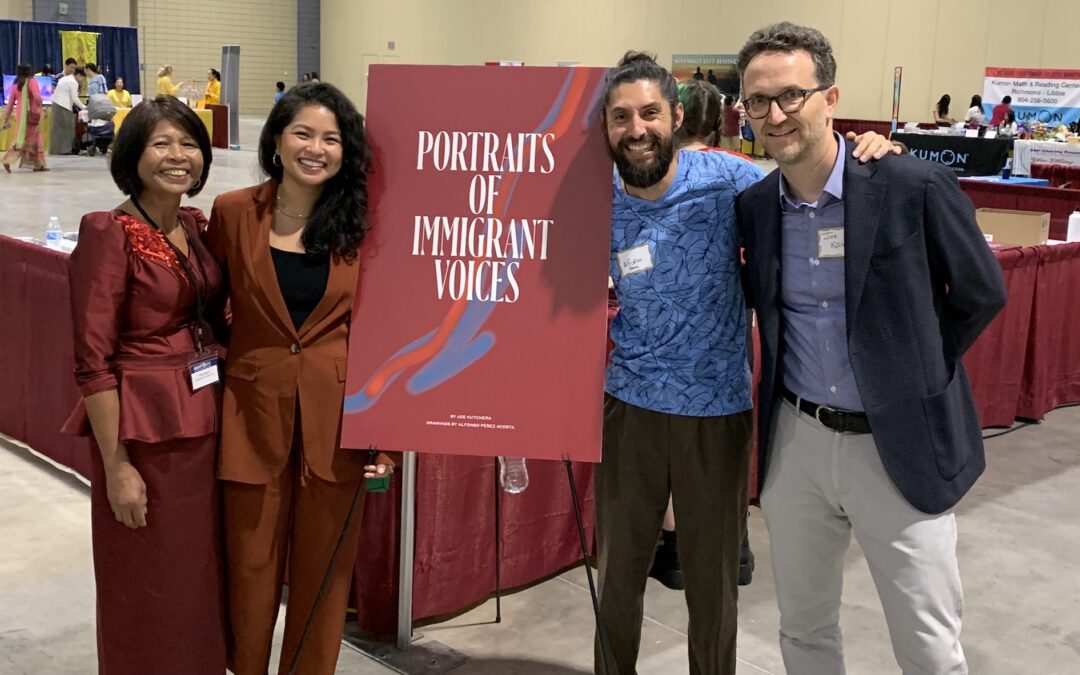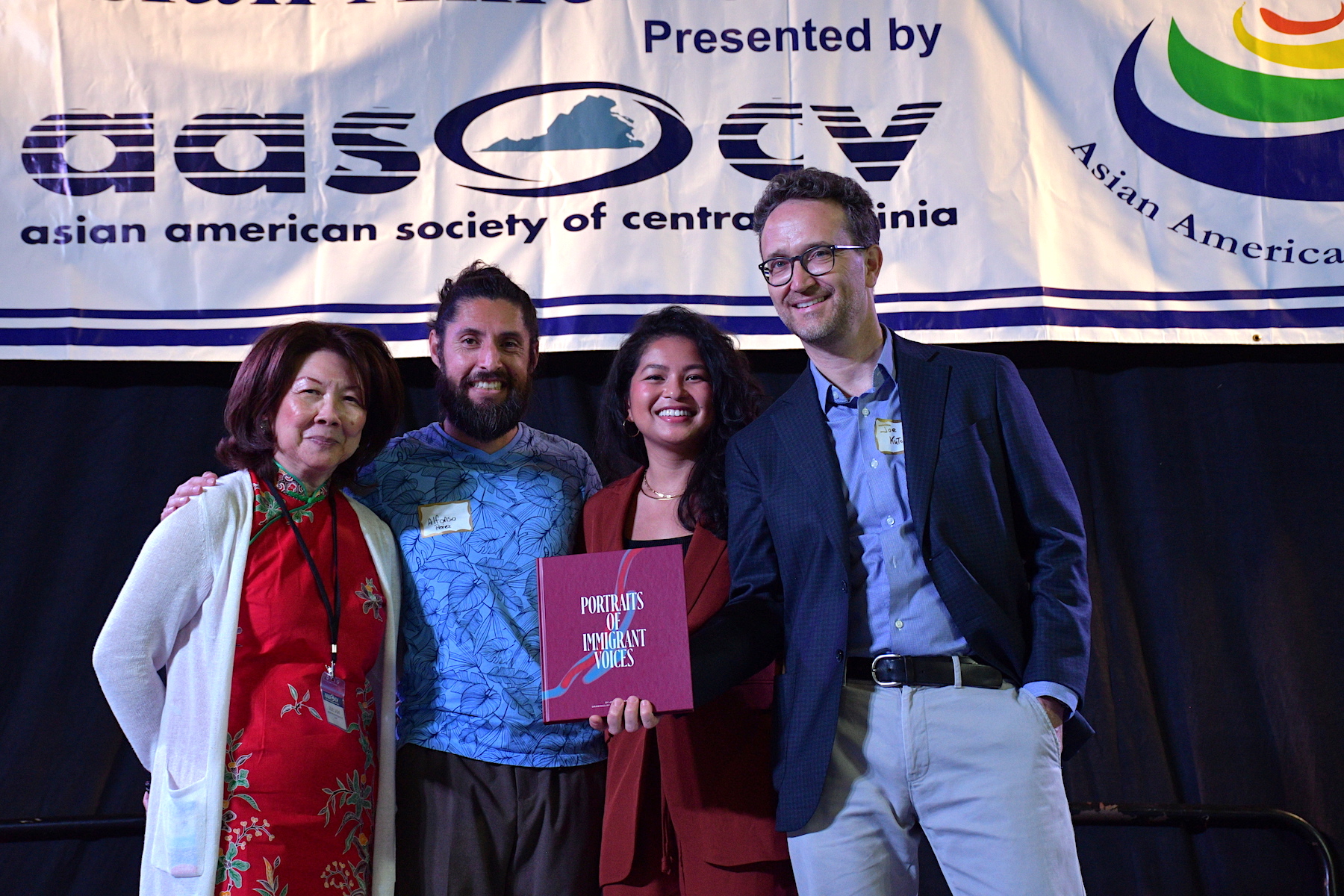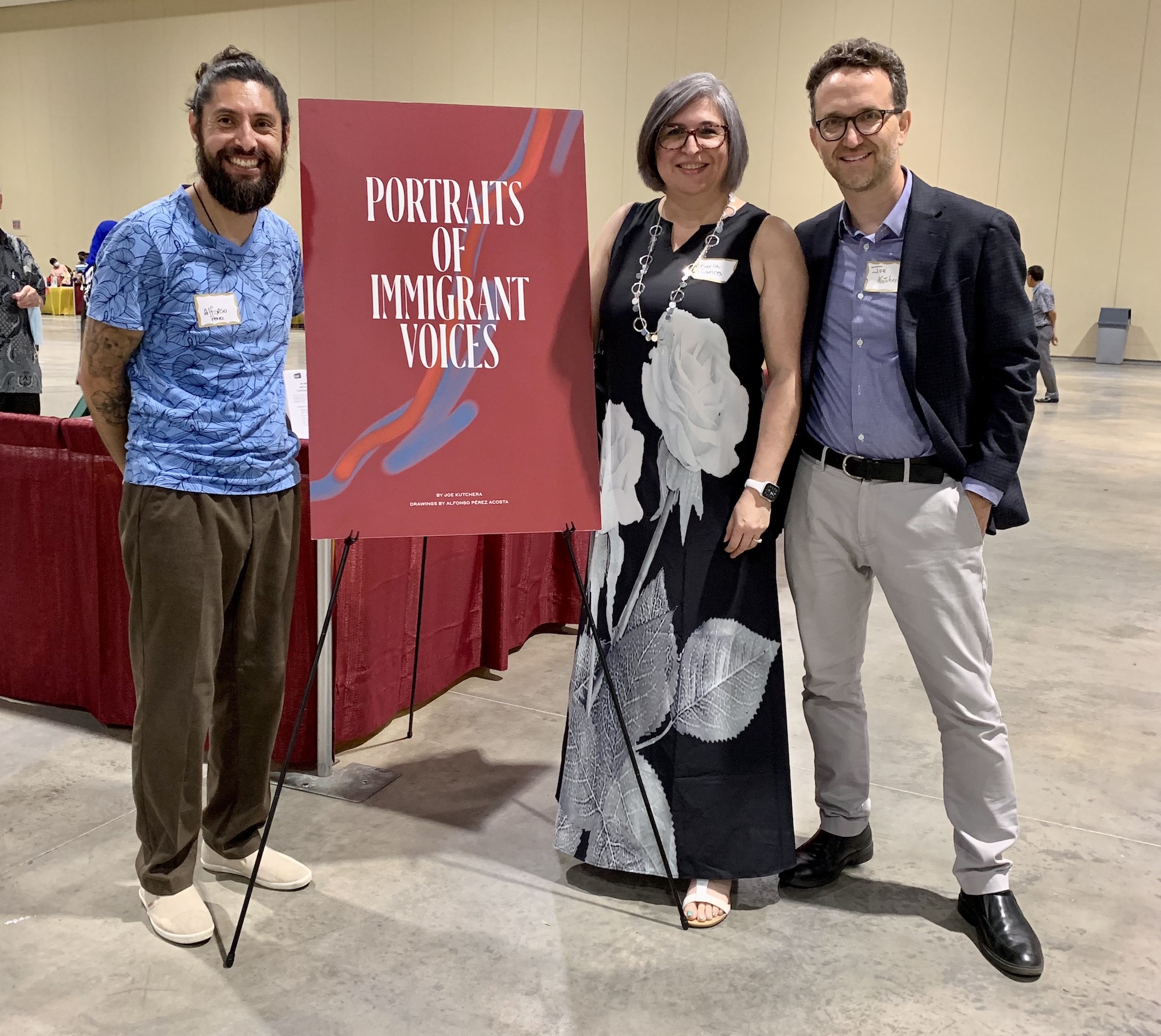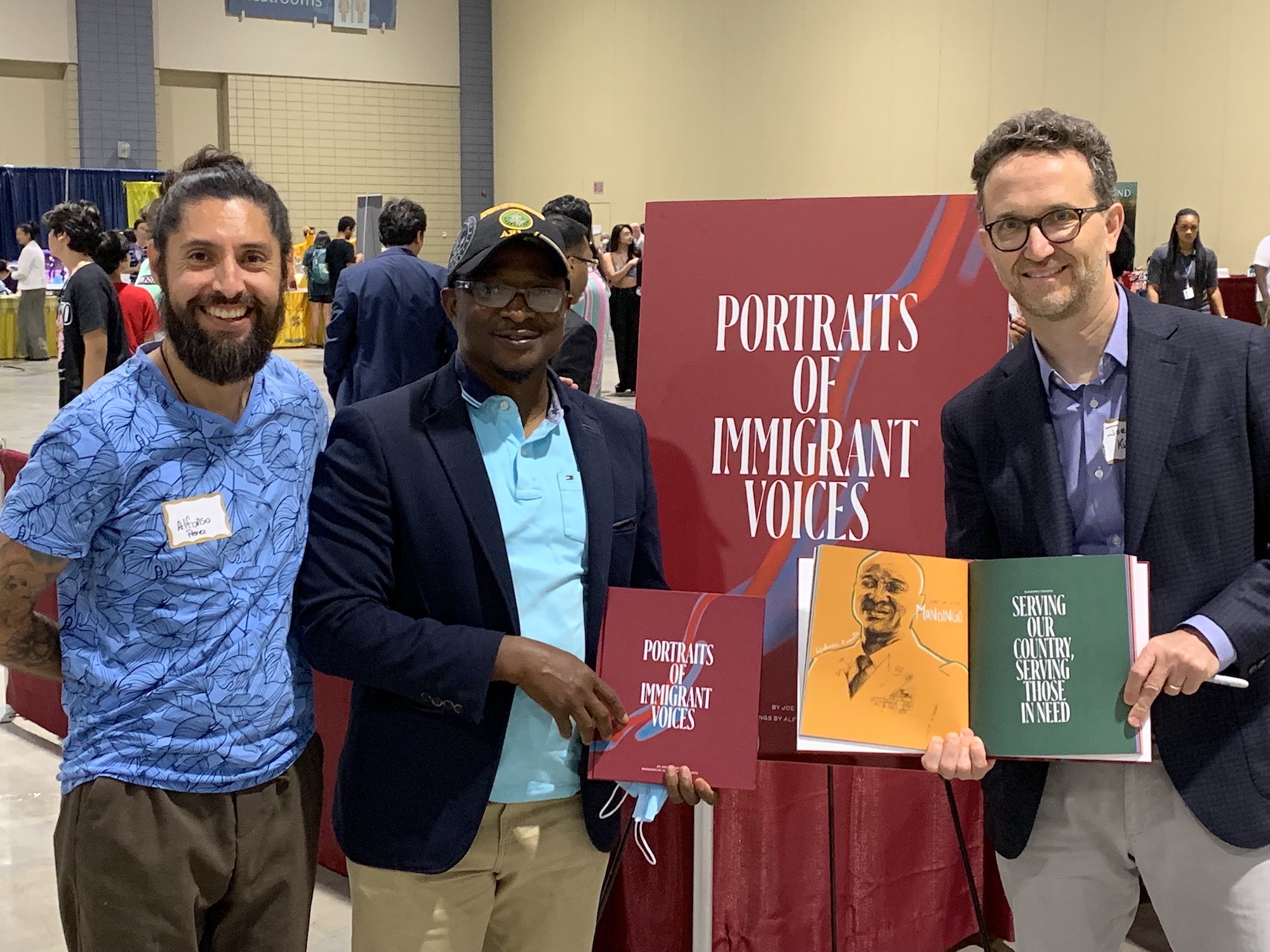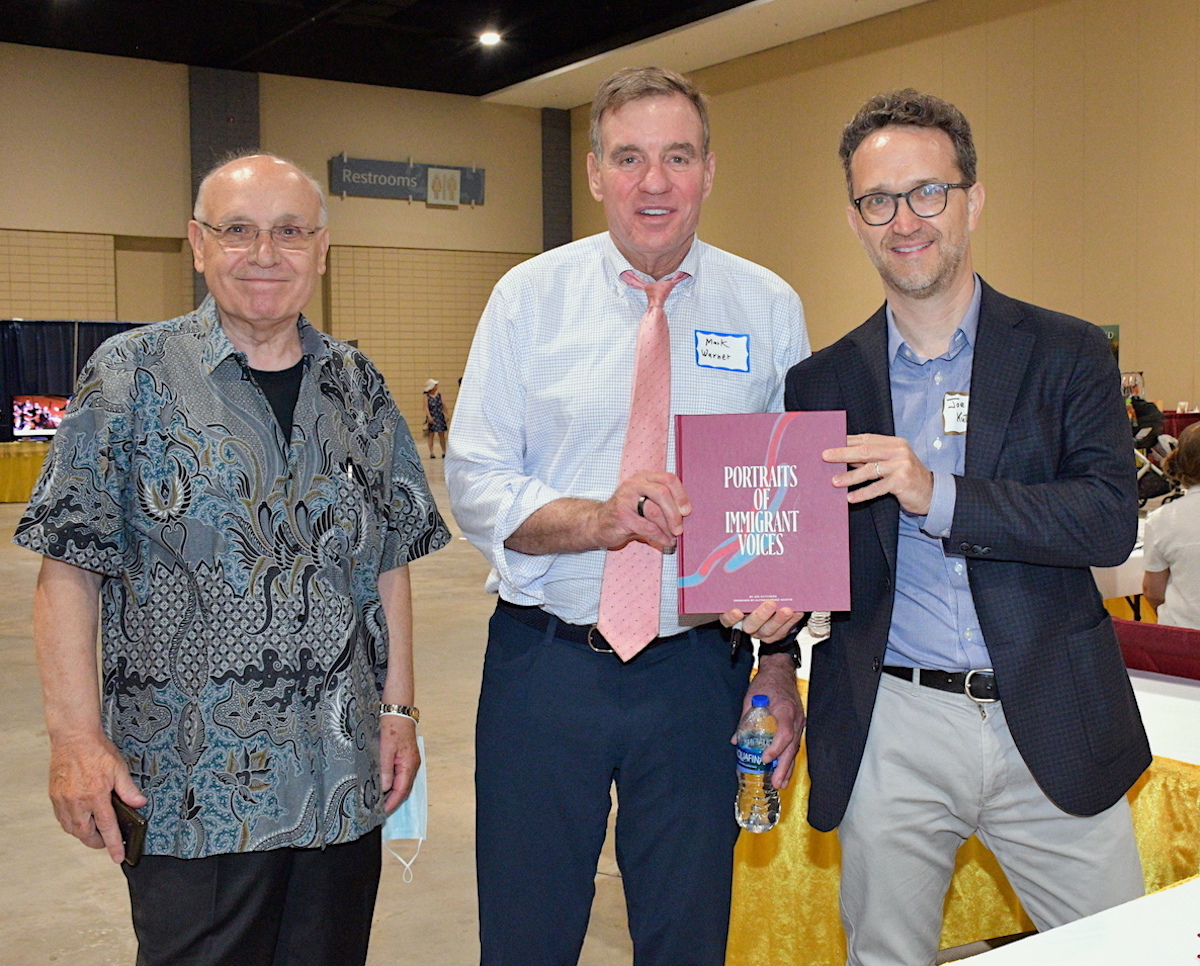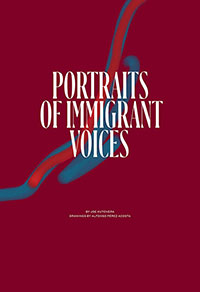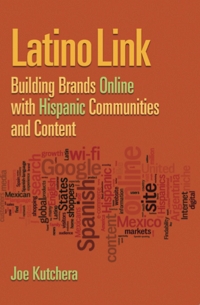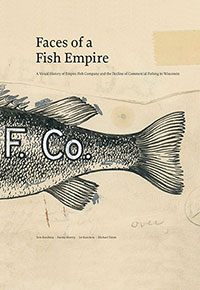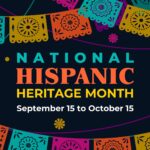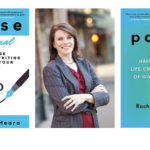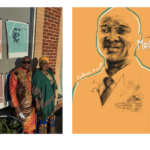Artist Alfonso Pérez Acosta and I are excited to launch our new hardcover coffee table art book, Portraits of Immigrant Voices, featuring the stories and portraits of 22 immigrants who have come to Richmond, Virginia from around the world. In a recent proclamation, President Biden dedicates the month of June to immigrants, stating, “This National Immigrant Heritage Month, we honor our immigrants and recommit to remaining a country worthy of their dreams and aspirations, a Nation true to our enduring values, and a democracy that forever stands as a beacon of hope to the world.” He goes on to write, “I call upon the people of the United States to learn more about the history of our Nation’s diverse and varied immigrant communities and to observe this month with appropriate programming and activities that remind us of the values of diversity, equity, and inclusion.”
Following is the introduction that I wrote for our new book, which is now on sale at Chop Suey Books in Richmond, Virginia. The author proceeds will benefit Afghan and Asian refugees who have settled in Virginia in a fund set up and managed by the Asian American Society of Central Virginia, a non-profit organization.
*****
Introduction: Stories of Gratitude, Progress, and Manifesting Dreams
During the fall of 2020, following the George Floyd protests along Richmond’s Monument Avenue, I saw an African American woman wearing a t-shirt with this message in bold letters.
I am my ancestors’ wildest dreams.
As a (white) writer, I was stunned at how one sentence could leave me speechless and make me feel such a wide range of emotions. At first, I felt infinitesimally small, humbled by the brutal African American history behind that sentence, reflecting the violence and intimidation that Black Americans experienced during slavery and Jim Crow, which kept them from America’s prosperity. And seconds later, the sentence made me feel incredibly hopeful as it communicated that great progress and change is indeed possible, measured through a multi-generational lens, taking into account the sacrifice and suffering of previous generations. The formerly wild dream of freedom and opportunity is now, we hope, finally possible for African Americans today, though we still have a long way to go to ensure equitable outcomes for all Americans.
Many Americans may know Richmond, Virginia (RVA) for its history as the capital of the Confederacy with its Civil War Museum and the now-removed statues of Robert E. Lee and Confederate generals along Monument Avenue. The ugly history of slavery and the myth of the ‘Lost Cause’ permeate so much of the city, but a more complex and hopeful picture of its citizens is emerging.
In decades past, a majority of RVA’s population has been Black, with Whites representing most of the remainder of its population. Yet, a more multicultural, and even international population, is growing out of RVA’s Black and White history. The 2020 Census shows that RVA’s African American population fell below 50%, while its White population increased as a result of gentrification. Blacks appear to have left Richmond City for the suburbs (Henrico and Chesterfield Counties), where the Black population increased. Yet, the Asian and Hispanic/Latino population grew by double digits in Richmond City, Henrico and Chesterfield Counties, and the people who selected “some other race” and “two or more races” grew by triple digits. This reflects an increase in children of interracial couples, immigrants from Africa (distinct from African Americans), as well as ‘mestizos,’ or people of mixed races, from Latin America. However small those populations might be now, the growth rates indicate that RVA, like the rest of the country, is becoming much more diverse.
With this in mind, I am grateful to be working with the Asian American Society of Central Virginia in sponsoring the publication of this book. AASoCV represents 18 diverse Asian communities that have stood up against racism and xenophobia, as described by AASoCV’s chair, Julie Laghi, in the foreword. AASoCV provides a perfect example of how people from vastly different language groups can come together to build community and cultural bridges, thereby promoting tolerance and diversity.
Our Team
AASoCV has enabled me and the team involved behind this book to take this project to the next level, furthering our mission to share immigrant stories and reflect on how they embody the American dream. Tida Tep, the daughter of Pim Bhut, featured on page 70, joins us to visually bring these stories into the printed medium. See Tida and her mom in the photo above.
Many thanks to Julie Laghi, the president of the Asian American Society of Central Virginia (left), and her entire organization for sponsoring our book project.
Our project initially began in an organic way. In August 2020, around the time that I saw the “I am my ancestors’ wildest dream” t-shirt, I received a call from Karla Almendarez-Ramos, who manages the City of Richmond’s Office of Immigrant and Refugee Engagement (OIRE). She asked me if I would be interested in and available to write profiles of immigrants as a celebration for National Immigrants’ Day on October 28, 2020. Richmond-based Colombian artist, teacher and muralist, Alfonso Pérez Acosta, had pitched the idea to Karla after crafting his initial computer-drawn portraits.
Artist Alfonso Pérez Acosta with Karla Ramos of the City of Richmond’s Office of Immigrant and Refugee Engagement (OIRE) and writer Joe Kutchera at our book launch during the Asian American Celebration
I immediately told her yes, that I would love to work on the project. I have written about and reflected on the subject of immigrants’ journeys previously, both interviewing recent immigrants and researching my own ancestors immigrating from Eastern Europe to the United States. My wife, Lulu, migrated from Mexico, to join me in Richmond in 2013. And previously, I had migrated to Mexico and the Czech Republic for work, during different chapters of my life. As a result, I also understand the immense challenges that immigrants face when moving to a new country.
National Immigrants’ Day has been celebrated since 1986, but mostly in places like New York City. We wanted to bring this celebration to Richmond, Virginia to highlight the diversity of its community and the variety of languages spoken (in addition to English). With the support of a grant from Virginia Humanities, we unveiled the portraits on October 28th, National Immigrants Day, on RVAStrong.org/portraits and published updates regularly through Thanksgiving, to honor our subject’s themes of gratitude. The exhibit’s social media campaign ran through December 18th, which the United Nations has named International Migrants Day as a testament to humanity’s “will to overcome adversity and live a better life.”
Many of the people we featured came as migrants initially, moving to the U.S. temporarily for work or educational opportunities. While others came as refugees, fleeing war and violence. And still others came here simply because they fell in love with an American! Yet, they all became immigrants when they decided to settle down permanently in the United States.
Each portrait features the subject’s name, country of origin, and language, written in both English and their respective language. To create the color behind each portrait, Alfonso blended all the colors from each subject’s flag of their home country to formulate that single, albeit blended color. For example, the red and white in the Swiss flag become pink behind Dominik Meier’s portrait (on page 62). I wrote personal histories to accompany each portrait to shed light on the challenges of migration and displacement, as well as explore the commonalities of learning to speak English and integrating into American culture. Their stories showcase the incredible creativity and ingenuity of these immigrants in overcoming numerous obstacles in their journey, some of whom have gone on to start companies and obtain graduate degrees.
What We Learned
In speaking with everyone we featured in this book, they have taught me how Richmond is a far more diverse and dynamic city than I ever realized. They truly appreciate America’s freedom, democracy, and the way that their neighbors have accepted them. As a result, I see Richmond and the United States through their eyes. In listening to their stories, I get the sense that they, too, have accomplished their dreams, and in some cases, even their ancestors’ wildest dreams.
Alfonso Pérez Acosta with Djakaria Konate (from Côte d’Ivoire) and Joe Kutchera at our book launch during the Asian American Celebration
“Virginia is for lovers. … But we need to keep that slogan alive,” says Mahmud Chowdhury, originally from Bangladesh (#19 in the series), referring to the state motto of Virginia. “Let’s continue to love each other, be our brother’s keeper and have each other’s back,” says Hannah Adesina, from Nigeria (#17 in the series). Immigrants are here “to demonstrate the best of ourselves, manifest our hopes and dreams,” says Brenda Aroche, from Guatemala (#13 in the series). And Ping Chu from China (#12 in the series) encourages us all in saying, “We need to build up a united country. This is the United States, right?”
The United States has an individualistic culture with an “I” oriented English language. Even though that is the case, the immigrants featured in this book have taught me that when we work together and support one another, WE can become our ancestors’ wildest dreams.
When Chinese New Year celebrations took place on February 1, 2022, the same day that Black History Month began, I learned that 2022 was the year of the tiger. I realized that 2022 couldn’t be a more perfect year for us to launch this book with a symbol of bravery, courage, and strength on our side.
Senator Mark Warner (center) buys a book from us at the AASoCV Asian Festival. Franco Laghi (left) is featured in the book on page 82.

